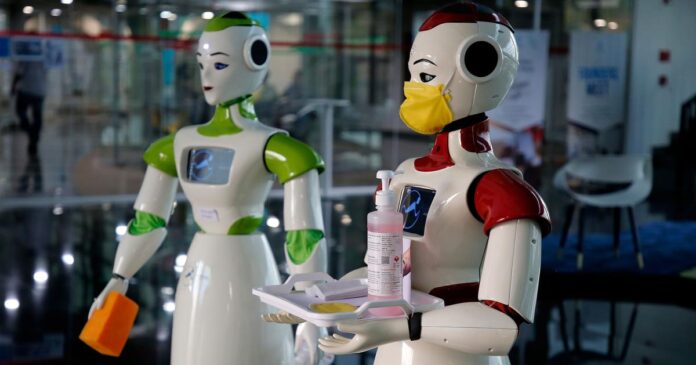
Do you remember watching The Terminator growing up? What about RoboCop or Transformers?
Back in the 1980s and ’90s, the thought of having robots walking among us and working in tandem with humans was nothing but a far-fetched idea. Fast forward to 2021, and they’re helping fight off a global pandemic alongside our frontline workers.
Now, in many parts of the world, you’ll find robots helping many industries during the pandemic.
Whether it’s a seemingly small task like delivering food to medics or one of the most vital responsibilities like sanitizing well-trafficked areas, you’ll find Rosey the Robot assisting.
Walking into a doctor’s office and being greeted by a robot who takes your temperature and kindly reminds you to put your mask on is no longer a far-fetched idea.
When the pandemic hit, the world — and more specifically, essential workers — realized they needed extra help and a way to do their regular tasks differently.
While trying to keep humans out of harm’s way and limit human-to-human contact as much as possible, many businesses deployed robotics to help on both small and large scales.
Here is a look at five ways robotics help in the fight against COVID-19.
Checking Temperatures
An easy but critical task during the pandemic is conducting temperature checks.
Many industries, including restaurants, movie theaters, and especially hospitals, now require people to get their temperatures checked upon entering a building. Human workers typically do this, but now robots are able to roll up to the front doors and take patrons’ temperatures via thermal cameras.
Using robots to check temperatures limits human-to-human contact and, therefore, the spread of the virus. This is especially important for hospitals — that’s one less opportunity for an essential worker to be exposed, and the establishment won’t have to station staff members in these highly trafficked areas.
Temperature checks conducted by robots enable nurses, doctors, and therapists to do their designated and more critical work.
These robotic helpers can also remind visitors and employees alike to wash their hands and wear their masks.
Running Errands and Delivering Food
While it may seem like a small task, robots can run errands and deliver food.
In the medical field, limiting mundane tasks for nurses, doctors, and other medical staff is a high priority during COVID-19. Having robots deliver food or supplies to overspent essential workers gives them more time to focus on patient relations, emergencies, and research to help further the fight against COVID.
A hospital near Austin, Texas, has human-like robots that fetch supplies and guide patients to their rooms. This saves time for medical staff, who no longer have to run these errands. It allows them to finish other tasks like running tests, checking on patients’ vitals, and giving vaccines.
In another helpful act for humankind, robots are delivering food to neighborhoods and homes. Albeit not as monumental as delivering supplies to hospitals, it reduces human contact, which helps reduce the spread of the virus.
A company utilizing these delivery robots in Milton Keynes is also waiving delivery fees to help out local residents.
Collecting DNA
To speed up COVID testing, doctors and engineers in Denmark created robots to take swab samples of the mouth.
These robots use computer vision and machine learning to figure out the perfect spot inside the person’s throat to swab.
While the idea of having a robot stick its arm in your mouth may sound unnerving, the accuracy of the robot is faster and more precise than a human being.
Cleaning and Sanitizing
A prominent and highly beneficial way that robots are helping to fight COVID-19 is by cleaning and sanitizing.
While frontline workers and essential employees around the world are focusing on the more crucial and time-sensitive tasks at hand, robots can take on the mundane (but still important!) responsibilities of cleaning and sanitizing.
Disinfecting robots use powerful UV lights, which destroy the DNA or RNA of any microorganisms in range.
Robotic cleaning is an incredible help in the fight against COVID-19 because while UV lights are highly effective at disinfecting, they are dangerous to humans. UV light can harm the eyes and cause sunburn or premature skin aging after long-term exposure.
The robots will autonomously clean areas when medical staff are not present to keep humans out of potentially hazardous conditions.
Serving as Doctor Look-Alikes
Another way robots limit human contact and keep doctors on the tasks that matter the most is by serving as stand-in doctors.
These robots aren’t giving medical advice of their own free will; they are just the messenger that visits the patient. Doctors and nurses can “talk” through these robots, much like a walkie-talkie system, and they can see the patient via cameras.
Essential workers at Circolo Hospital in northern Italy use robots as their avatars, “enabling them to check on their patients around the clock while minimizing exposure and conserving protective equipment.”
Visiting patients this way enables nurses, doctors, and staff to give the maximum amount of help required by their patients.
Again, this limits the risk of human-to-human contact and the potential spread of the virus.
Robots are Supporting the Fight Against COVID-19
Whether the tasks are big or small, robots are helping combat COVID-19 in a novel way.
By checking temperatures, delivering food to neighborhoods and businesses, and stepping in as doctors, robotics limit human interaction — reducing the virus’s spread.
As the world continues to fight against this pandemic, utilizing innovative avenues like robotics and automation that enable humans to focus on more pressing matters can be a way to kick this virus sooner than later.
Companies continue to make more intricate robots to help out essential workers and researchers in the battle against COVID-19. What type of robot do you think will be next?
About the author:
 David LaCoste has worked in the water Treatment, Hazardous Waste, and Industrial Cleaning market segments for over 30 years. He has been in an Operations and Business Development role with Ecorobotics, LLC for the past 7 years.
David LaCoste has worked in the water Treatment, Hazardous Waste, and Industrial Cleaning market segments for over 30 years. He has been in an Operations and Business Development role with Ecorobotics, LLC for the past 7 years.





















